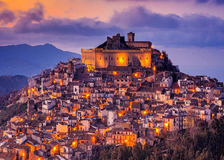Mediterranean history - under the volcano
地中海的历史-于火山下
The Invention of Sicily. By Jamie Mackay.
《西西里岛起源》杰米·麦凯
Sicily beguiles. It offers coves with limpid water; Greek temples, such as those at Agrigento and Segesta, that are among the best preserved in the Mediterranean; a Roman amphitheatre at Taormina still used for its original dramatic purpose; grandiose Baroque palazzi; bustling street markets; some of the best food to be had in Italy; an expanding range of fine wines at reasonable prices; and a cathedral in Palermo that is a riot of eclecticism. Etna on a spring morning, still capped with snow and belching smoke, is among Europe’s greatest sights.
西西里令人着迷。它有清澈的海水;有希腊神庙,地中海保存最完好的就位于阿格里琴托和塞格斯塔;有罗马露天剧场,陶尔米纳的那个剧场仍保留了最初的戏剧用途;有宏伟的巴洛克式宫殿;有熙熙攘攘的街市;有意大利一些最好的食物;有品种繁多且价格合理的优质葡萄酒;有位于巴勒莫融合了各种折衷主义设计的大教堂。春天的早晨,埃特纳火山仍被积雪和薄雾覆盖,这是欧洲最壮丽的景观之一。
misawecev66pzmlojz40kvsueo9bxwvi.jpg
The ancient Greeks saw Sicily as rich and fertile yet “dangerous and unpredictable”. For Jamie Mackay, author of this brief and pacey history of the island, their perception reflected a dual view of Sicily that would be expressed in different forms up to the present day. In Mr Mackay’s telling, a tipping-point arrived at the dawn of the 14th century after several hundred years of relatively enlightened rule by Byzantine Greeks, Arabs and Normans. The uprising that came to be known as the Sicilian Vespers sparked a war that led to the expulsion of the island’s French rulers. But it is only too characteristic of Sicily’s ill fortune that this popular victory should ultimately have had such dismal effects.
古希腊人认为西西里岛是个肥沃富饶之地,但它“危险且不可预测”。杰米·麦凯讲述了这座岛简短而充满活力的历史,在他看来,他们的这种想法反映了人们对西西里岛的双重看法,这种看法直到今天仍以不同的形式表现出来。麦凯先生讲述道,经过拜占庭希腊人、阿拉伯人和诺曼人几百年相对开明的统治之后,一个转折点出现在14世纪初。后来被称为西西里晚祷的起义引发了一场战争,导致岛上的法国统治者被驱逐。但是,这场人民的胜利最终竟产生了如此令人沮丧的后果,这正是西西里岛不幸的典型。
Sovereignty over an ethnically and religiously diverse island passed, via the rulers of Aragon and Catalonia, to those of a newly unified Spain, obsessed with confessional uniformity and, by implication, racial purity. Sicily became an outlying territory in an empire that favoured traditional social arrangements and a profoundly conservative form of Catholicism. For almost 400 years, Mr Mackay notes, Sicily had been governed by an urban elite in Palermo. “Following the Vespers, though, power moved progressively away from these individuals, and into the hands of rural landowners and church authorities.”
主张种族和宗教多样化的时代已经过去,从阿拉贡和加泰罗尼亚的统治者,到新近统一的西班牙统治者,都痴迷宗教统一,也暗中追求着种族纯洁性。西西里岛曾是罗马帝国的一个边缘地区,那时帝国偏爱传统的社会制度和极度保守的天主教组织。麦凯指出,近400年来,西西里一直由巴勒莫的城市精英统治。“然而,晚祷起义之后,权力逐渐从这些人手中转移到了农村土地所有者和教会权威的手中。”
A strand of popular heterodoxy endured, half-surfacing as superstition, the secret worship of polytheistic deities and even the practice of magic. But among the results of Sicily’s incorporation into the Spanish Empire was that it was barely affected by Renaissance humanism. Being part of the empire did, however, shield it from the worst effects of the decline in Mediterranean trade prompted by the colonisation of the Americas. And, after Sicily became part of the Kingdom of Naples, it got a whiff of the Enlightenment, thanks to the Bourbon monarch who would become Charles III of Spain. A second apparent liberation, by Giuseppe Garibaldi and a small army of Italian nationalists, again turned sour: Italy’s new, Piedmontese rulers bungled the peace that followed, and Sicily’s nascent Mafia exploited the chaos.
一连串风靡一时的异端邪说持续蔓延,迷信、对多神教神灵的秘密崇拜,甚至是魔法实践涌出水面。西西里并入西班牙帝国产生了诸多后果,但它几乎没有受到文艺复兴人文主义的影响。然而,作为帝国的一部分,它确实避免了美洲殖民引发的地中海贸易衰落所带来的最坏影响。在成为那不勒斯王国的一部分后,幸亏有了波旁王朝君主西班牙查理三世,西西里岛受到了启蒙运动的影响。由朱塞佩·加里波第和一小群意大利民族主义者领导的第二次浮于表面的解放运动再次失败:意大利新的皮埃蒙特统治者打破了随后到来的和平,而西西里新生的黑手党利用了这次混乱。
Mr Mackay is at his best when he weaves concise descriptions of customs, social changes, legends and cultural glories through this tumultuous narrative. Artistically, Sicily’s historical relationship with the Italian mainland bears some similarity to Ireland’s with Britain: an island with a disproportionately small middle class, sandwiched between a vast, uneducated peasantry and a landowning aristocracy largely indifferent to culture, which nevertheless produced a string of literary, artistic and musical giants. Vincenzo Bellini, Giovanni Verga, Luigi Pirandello, Leonardo Sciascia, Renato Guttuso, Giuseppe Tomasi di Lampedusa and, most recently, Andrea Camilleri, were all Sicilians.
麦凯最出色的地方在于,他在纷乱的叙事中,穿插了对风俗、社会变化、传说和文化成就的简洁描述。在艺术上,西西里与意大利大陆的历史关系和爱尔兰与英国之间的历史关系有些相似:这座岛屿上的中产阶级少得不成比例,他们夹在广大未受过教育的农民和对文化漠不关心但拥有土地的贵族之间,却产生了一系列文学、艺术和音乐巨匠。文森佐·贝里尼,乔瓦尼·维尔加,路伊吉·皮兰德娄,莱奥纳多·夏夏,雷纳托·古图索,朱塞佩·托马西·迪·兰佩杜萨,以及最近的安德烈亚·卡米莱里都是西西里人。
The author is at his worst when he fails to check his facts and verify his assertions. He appears to take as historically reliable the legendary founding date of Rome, describes the Benedictines and Jesuits as “sects” and makes Oscar Luigi Scalfaro prime minister of Italy, a post Mr Scalfaro never held. These are unfortunate missteps in an enjoyable canter across a history, and a place, which are entrancing and disturbing by turns.
作者没有核对他所写的事实和证实他的主张,这是最糟糕的一点。他似乎认为罗马传奇般的建立日期在历史上是可靠的,将本笃会和耶稣会士描述为“教派”,又将奥斯卡·路易吉·斯卡尔法罗写成意大利总理,而斯卡尔法罗从未担任过这个职位。这些失误令人感到遗憾,它们穿插在这段在历史之中、城市之间愉快慢跑的路上,欣喜与困扰交替而来。
来源:经济学人

参与评论